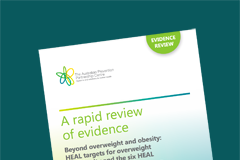Beyond overweight and obesity: HEAL targets for overweight and obesity and the six HEAL objectives
This rapid review examines the broader health and other outcomes, beyond overweight and obesity, likely to accrue as a consequence of implementation of the NSW Healthy Eating Active Living Strategy.
Background
This rapid review examined the broader health and other outcomes, beyond overweight and obesity, likely to accrue as a consequence of implementation of the NSW Healthy Eating Active Living Strategy. Specific questions were to:
- Identify the additional health conditions and wellbeing indicators (beyond overweight and obesity) where there is strong evidence that meeting the HEAL targets for overweight and obesity and six objectives will improve outcomes
- Provide information on the level of change in the targets and HEAL objectives that are associated with better outcomes for the health conditions and wellbeing indicators.
Key findings include
- Reducing overweight and obesity and associated health behaviours among children and adolescents improves outcomes for metabolic risk factors, dental health, hypertension, cardiovascular disease risk factors, depression, rates of mortality in hospitalised children, bullying and otitis media.
- A substantial number of direct and indirect health and other outcomes may occur as a result of stabilisation and/or reduction of the prevalence of overweight and obesity among adults.
- There is:
- a limited amount of evidence relating to reduced intake of energy dense nutrient poor food to health and other outcomes, including and beyond overweight and obesity
- substantial evidence linking increased consumption of fruit and vegetables to a large number of reduced morbidities and mortality
- a large body of evidence linking the intake of sugar-sweetened beverages to a number of health outcomes, including type 2 diabetes, pancreatic cancer, coronary heart disease, stroke and hypertension
- an abundance of evidence supporting health and other outcomes from increased physical activity and reduced sedentary behaviours.
- There is a lack of systematic review evidence linking community awareness directly to outcomes beyond health behaviours and their antecedents.
- Addressing the HEAL strategy objectives suggest that every year in NSW, the following would be prevented:
- 37 cases of colorectal cancer (through increased physical activity)
- 1003 cases of coronary heart disease (through improved vegetable consumption) and 422 cases of coronary heart disease (through improved fruit consumption)
- 510 cases of type 2 diabetes (through reduced sugar-sweetened beverage consumption) and 266 cases of type 2 diabetes in men and 200 cases in women (through a 5% reduction in overweight)
- 185 cases of type 2 diabetes in men and 186 cases in women (through a 5% reduction in obesity)
- 366 deaths from all causes (through reduced sedentary behaviour).
- The impact of achieving the HEAL targets for overweight and obesity as well as other direct and indirect health and non-health impacts is likely to be substantial. In addition, although not additive, the impacts are likely to be cumulative.
